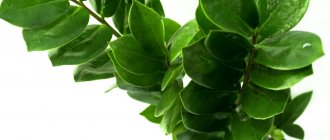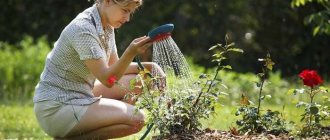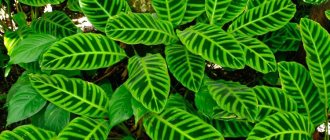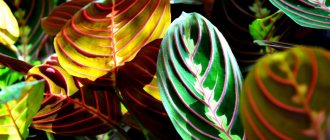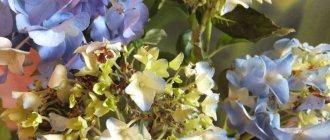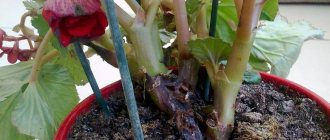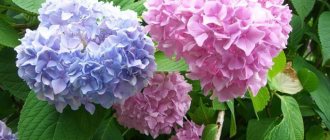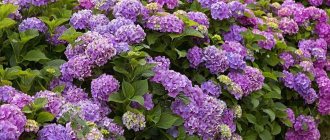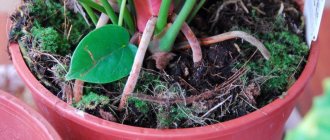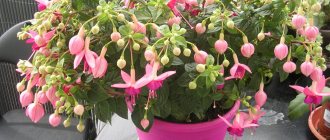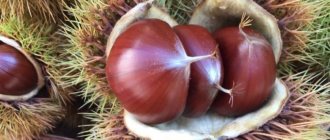Why palm leaves dry out: main reasons
Although most indoor palms are true tropical plants, they do not tolerate heat well, especially if high temperatures are accompanied by low indoor humidity.
The risk of leaves drying out at the tips increases significantly during the heating season, when currents of hot air rise from the radiators.
In addition to these factors, a palm tree can dry leaves in the following situations:
- Temperature changes or exposure to drafts;
- Frequent transplants unnecessarily;
- Improper watering (severe drying out or waterlogging of the earthen clod);
- Mineral fasting;
- Impact of pests and consequences of diseases.
Keeping the palm tree in a suitable microclimate and normalizing care solves the problem of drying leaves.
Important: if you find dried leaves on a palm tree, do not panic - often the lower tier dies off on its own as the crown grows.
Low air humidity: what to do?
Dry air not only does not add beauty to a home palm tree, but also affects its health, reducing resistance to pests and diseases.
That is why the primary task is to normalize humidity, which can be achieved in several ways:
- Spray the leaves daily with a spray bottle. You need to use warm, settled water, dispersing it with a fine spray.
- Install special devices. An electric humidifier is an ideal solution during the heating season.
- Create natural hydration. Several pots with plants, bowls with expanded clay, filled with water, release moisture, maintaining an optimal microclimate.
Additionally, you can cover the batteries with a wet towel if the pot with a palm tree is on a windowsill or near a window.
Ventilate the room periodically if the outside temperature rises above zero. Bathing in a warm shower will also benefit the plant and improve the condition of the foliage.
Unsuitable temperature and drafts
Winter maintenance of a home palm tree should be given special attention, since it is during the cold months that the plant is at rest, accumulating strength for future active growth.
“Equatorial” indoor temperatures are the worst thing you can do to a palm tree during its resting period. The heat causes the leaves to dry out, the crop loses its attractive appearance and subsequently takes a long time to recover.
The temperature in the room must be maintained depending on the type:
- +8-+12 degrees – for Washingtonia, trachycarpus and brachea;
- about +24 – for the Robelena date, chamedorea and areca;
- +16 degrees – for rapis, rapalostilis and sabal.
Without ventilation, palm tree leaves dry out at the tips, and drafts harm the crown. Maintain a balance - take the pot out of the room when you open the window so that the green mass is not damaged by cold air flows.
Frequent transfers
Improper replanting is the reason why palm leaves may turn yellow and dry at the tips. It is necessary to transfer the plant into a new pot only after the earthen clod has been completely developed, so that the sensitive root system is not injured.
Young specimens need to be replanted once a year, adult palm trees - every 2-3 years. Large trees in massive tubs are not touched, but only the top layer of soil is replaced with fresh soil and fed regularly.
An unscheduled transplant is justified only if the palm tree is sick and needs to resuscitate the root system or completely replace the soil.
Similar situations arise when there is an invasion of pests, the development of root rot and severe waterlogging of the soil in the pot.
Improper watering
Lack of moisture in the soil inevitably affects the green mass of the palm tree, causing the tips to dry out. Excessive watering is fraught with similar external consequences, but the root system suffers more in such a situation.
A dried palm tree can be watered, but a plant that has suffered from waterlogging requires serious measures.
Simple recommendations will help you avoid mistakes in watering:
- Moisten the soil in the pot only after the top layer (2-3 cm) has dried.
- Use warm or room temperature water, allowing it to sit for several days until sediment forms and the chlorine evaporates.
- Drain off any liquid that remains in the pan half an hour after watering.
- In winter, moisten the substrate less often than in summer, since moisture evaporates more slowly in cool conditions.
A home palm tree needs a high-quality drainage system that prevents moisture from stagnating around the roots. Make sure that there are special holes at the bottom of the pot, and before each transplant, lay a layer of expanded clay before filling the soil.
How to prevent diseases of domestic palm trees?
Timely prevention of diseases in plants guarantees their healthy growth and development. Most of these diseases are easier to prevent than to cure, and this is easy to achieve if you take care of the tree. It will tell with its entire appearance how he feels and what needs to be done. Experienced florists regularly inspect plants and always have treatment products on hand.
The presence of diseases can be indicated by:
- change in leaf color;
- wilting of the plant;
- the appearance of various spots, plaque;
- the presence of pathological growths.
The specificity of the “clinic” depends on the specific disease, which has certain symptoms. To prevent infection, it is necessary to monitor the palm tree and maintain its vitality. It is enough to carry out certain activities, which are presented in the table:
| Event | What does it include |
| Proper watering | Diseases often develop due to the use of too hard water, waterlogging, or vice versa - due to lack of moisture. Skip tap water and use rainwater, which is cleaner and healthier than tap water. |
| High quality soil | Some pests can be brought in with the soil you collected from your site. The mass should be heated in the oven for several minutes. It is better to buy the substrate in the store. |
| Fertilizers | Diseases more often develop in palm trees that receive poor nutrition. Apply fertilizers in the right quantities and you will always have a healthy flower. |
| Timely transplant | When a plant is cramped in a pot, it needs to be replanted. If this is not done, various diseases appear. |
Keep an eye on the plant and the risks of disease development will be minimal. Regularly inspect palm trees for various growths or growth abnormalities. If there are pests or infections, treat with specialized products.
Palm diseases: why leaves turn yellow and dry at home
The widespread use of palm trees is explained by their high decorative value and relative ease of care. The exotic beauty is often placed in offices, living rooms, and resort and sanitary facilities, not only as decoration, but also to purify the air of toxic substances. But if not properly cared for at home, the leaves of the palm tree begin to dry out, which significantly spoils its appearance. To save the plant, it is necessary to become more familiar with the causes of the development of this disease and control measures.
My home palm tree's leaves are drying up, should I worry?
In order for your worries about dried leaves not to be in vain, you should know that there are also natural reasons for such manifestations.
The trunk of the palm tree is not covered with bark, but is formed by cuttings of dry lower leaves, which are periodically trimmed during artificial cultivation. In nature, such leaves form a kind of skirt, which falls to the ground over time.
If only the lower old leaves of a palm tree are drying out, and all the rest look healthy, there is no need to worry. In this case, the reason is due to natural factors.
The main causes of problems and diseases of domestic palm trees
In most cases, the leaves of the plant turn yellow due to an unfavorable microclimate in the room, irregularities in care and damage by diseases and harmful insects.
Conditions of detention
For an indoor tropical plant, it is very important to be in a room with a high level of humidity. Dry air, especially during the heating season, has a detrimental effect on it; the leaf plates begin to dry out, and in a short time they can even die off. In winter, the recommended temperature should be in the range of +15-20 °C. There is an opinion that pruning a palm tree in such situations is a real salvation, but this is wrong. For phytobeauty, it is best to grow in humid conditions.
To create a microclimate in the room favorable for the palm tree, it is necessary to regularly spray both the air around it and the top layer of soil in the flowerpot. But frequent and abundant irrigation should be avoided, otherwise there is a high probability of root rot that will destroy the flower crop.
For comfortable growth and development of a palm tree, it is worth protecting it from drafts and direct sunlight on the leaf plates. The optimal solution is to identify a palm tree 1 m from the window. It is more effective for her to receive bright but diffused light.
In winter, drafts can harm a tropical guest in just a matter of days. Its leaf mass will begin to lose its natural color, becoming yellow, brown or completely black. Such plates quickly fall off, the flower withers and dies. You can protect the palm tree from cold and damp air in the room during ventilation by using a cloth to cover it, or take it out of the room. Fresh air flow is especially necessary for evergreen plantings; it significantly activates all growth processes.
Care errors
The home palm tree, although not a capricious plant, if there are serious mistakes in terms of care, it begins to hurt, the tips of the leaves turn yellow and dry out. Often the cause of such negative phenomena is an incorrectly performed flower transplant. It is recommended to perform this manipulation only during the period when the roots of the palm tree have completely entwined the earthen ball. This will minimize the likelihood of injury to the root system.
The frequency of replanting young plants is once a year, adult specimens under the age of 6 years - once every 2-3 years. Subsequent procedures will be almost impossible; lifting a large palm tree is very problematic. Here it is enough to replace the top layer of soil with new soil enriched with useful components.
If necessary, a green pet can be transplanted unscheduled. This is relevant for identifying harmful insects on a palm tree, where a complete replacement of the soil substrate is required. In addition, forced replacement of soil can also be carried out when rot develops on the roots due to waterlogging, or when the soil mixture in the flowerpot becomes very waterlogged.
You should care for the exotic beauty competently, not allowing the earthen coma to dry out. Lack of moisture, as well as its excess, cause serious damage to the health of the plant, especially its underground part.
Non-communicable diseases
– Drying of leaves . It begins with browning of the tips of the leaves, which then covers the entire leaf area. The reason may be dry air in the room, a sudden change in the maintenance regime, for example, moving a plant from a greenhouse to a living room, as well as rotting of the roots as a result of stagnation of water in the pot due to clogging of the drainage hole in the bottom of the pot or accumulation of water in the flowerpot.
– Sunburn . If a plant stands on a balcony in the spring, unprotected from direct sunlight, unsightly burn spots with brown edges appear on the leaves.
– Yellow spot . It may appear on the leaves when the earthen ball is over-moistened and overcooled or when the substrate is too dense and does not allow air to pass through to the roots. Such a palm tree must be kept on dry land, and when watering, use warm (not lower than 22 degrees) water.
It is absolutely clear that it is much easier to prevent a disease than to fight it later. To do this, you need to provide the plant with proper maintenance and care, i.e. free placement that does not interfere with air circulation, plant cleanliness achieved by regular washing, as well as optimal temperature and humidity conditions.
pest control products
If you still had to resort to chemicals, you must remember that they are all poisonous to humans to one degree or another, often have an unpleasant odor and their use in rooms is dangerous. In addition, before treating the plant with any chemical, it is necessary to check on a small area of the leaf how the plant reacts to it, whether it will harm the palm tree. Knowing the disease or pest, you can prevent the death of the plant. Good luck to you.
How to revive a plant
To revive palm trees in the event of leaf blades drying out and turning yellow, you need to create the most favorable microclimate in the room. The room should be warm and humid. You can effectively increase the humidity level with a spray bottle, spraying the air near your green pet. It is enough to treat the leaves with water three times a week, just use soft, settled water.
If the reason for the drying of the palm tree is problems with the root system, then they need to be solved and the condition of the soil substrate must be monitored in the future. Neither overwatering nor drying out of the soil should be allowed. It is recommended to use only sharp and disinfected instruments to remove diseased roots. In most cases, replanting saves the plants.
The palm tree occupies one of the leading positions in home floriculture. The main thing is to prevent its leaf plates from drying out and turning yellow, you need to maintain optimal temperature conditions, humidity levels and not ignore the basic rules of care.
The date palm is drying up - what to do?
The main cause of disease, as a rule, is improper care. The plant can get sick due to non-compliance with heat, humidity and lighting. Why does the date palm dry out and what signs can be used to determine what is wrong with the tree?
- If you notice that the trunk of a palm tree has become soft and emits an unpleasant smell with a hint of putrefaction, while the leaves have changed their color and become dark, almost brown, then most likely you have overdone the watering.
What to do? Of course, the first thing to do is stop watering and dry out the soil. It is better to remove the palm tree from the pot and carefully examine the roots. If the roots have darkened, become watery and soft, you are probably too late, and you will no longer be able to save the plant. If not all roots have died, but there are still living ones, a separation operation must be performed. Cut off all bad roots and sprinkle the “wounds” with charcoal powder.
- Darkened tips of the leaves that acquire a brown tint are evidence that the air in the room is too dry, or the tree has been exposed to draft conditions and has been subjected to a sharp temperature change.
What to do? Dead leaves are removed, and this should be done with a sharp knife, and not by tearing them off. At the same time, if you already have an adult date palm, and the leaves in the lower part of the plant turn yellow, this is a normal phenomenon characteristic of a developing plant.
This property of the date palm (shedding its lower leaves) was used in ancient Egypt as a primitive calendar. In one month, a date palm has just enough time to grow one new leaf and one old one to die.
- If your date palm has a pale appearance, it may be due to excessive light or pest infestation, particularly red spider mites.
What to do? In this case, shade the plant a little to protect it from direct sunlight.
- You have noticed that the leaves of the tree are darkening, starting to curl into a tube and fall off, and small brown plaques have appeared on their surface. In other words, the date palm is drying up, what should I do ?
All these signs indicate that unexpected guests have settled on your tree. It could be a mealybug, or a thyroid mite, or a spider mite. The procedure in this case is as follows:
- wash the leaves with soapy water (it is better to use simple laundry soap),
- sprinkle the dried leaves with garlic solution,
- if the lesion has gone far, use Actellik solution.
- If you observe normal condition and growth of the date palm trunk, but the leaves dry out and curl at the edges (even if they do not change color), this indicates that you are not watering the plant enough and the air in the room is too dry.
What to do? Carefully trim the dried edges without touching the green (living) part, so that a thin yellow stripe remains along the edges. Only leaves that have dried entirely can be completely removed, otherwise this problem will spread to other leaves. Place a container of water near the plant, or move the pot away from heating devices, or come up with another convenient way to increase the humidity in the pot area.
Why do the leaves of the domestic palm tree dry out?
The main reason for the drying out of any indoor plant is lack of watering and excessive dry air. In this case, the leaves of the date palm dry out, curling at the edges. Sometimes they turn yellow, sometimes they do not change color.
This problem is easy to deal with:
- carefully remove the dry edges without touching the fresh part;
- if the entire leaf has dried out, cut it off completely;
- move the tub with the palm tree away from radiators and other heating systems;
- Place a humidifier or just a basin of water next to the plant;
- set up a proper watering system.
You can remove unexpected settlers using a solution of laundry soap or garlic (the leaves are washed with the first, sprayed with the second).
The ends of palm leaves may darken due to temperature changes or drafts. In this case, the diseased leaves just need to be cut off, the plant will produce new ones. Yellowing and falling leaves at the bottom of the tree is considered normal. Thanks to this quality, the ancient Egyptians used the date palm as a kind of calendar. After all, in a month a tree manages to grow one fresh leaf.
How to provide the date palm with proper care?
When growing a plant indoors, you need to provide it with the most acceptable care. If lighting is easier in this sense, then watering can be difficult to guess, because we don’t see what’s happening inside the pot, and piercing the soil in the pot is dangerous - you can damage the roots. You can check soil moisture in the following way. Tap the pot from top to bottom with your knuckles. A hollow sound means the soil is dry, a dull sound means the soil is wet.
If the soil composition is correct, you can water the pot until water flows into the pan. The water that spilled there should be removed after 2-3 hours, if it remains there. Water the palm tree, like most indoor plants, with settled water at room temperature.
Recommended soil composition
Depending on the age of the plant, the composition of the soil also changes.
- For a young plant, the following composition is suitable: 2 parts light turf soil, 1 part humus, 0.5 parts leaf, 0.5 parts sand.
- For a date palm 5-10 years old, the following composition is suitable: 1 part each of turf soil, compost, humus and sand.
- At the age of over 10 years, the following composition will be optimal: 2 parts turf, 2 parts compost, 1 part humus, 1 part sand.
Date palm from seed
Not everyone knows that it’s easy to grow a date palm yourself from an ordinary date that we buy in a store, or rather, from the seeds left over from it. True, this will take time. Place the date pit in plain water for several days, changing it daily. To make sprouts appear faster, it is recommended to scald the seed before planting. Dates that have been lying around for a long time are unlikely to sprout quickly, but nothing depends on us here.
The seed is pushed vertically into the ground so that the soil covers it by 1 cm. The ideal temperature for germination is 25-30 o C. Usually shoots appear after 2-3 months, but at first the tree grows very modestly. And only after 5-7 years will your room be fully decorated by a beautiful representative of the palm family.
